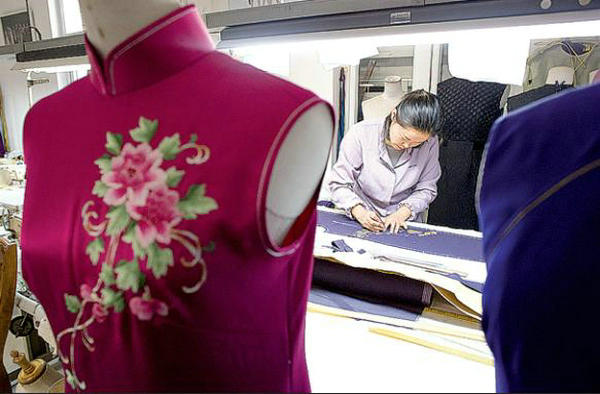 |
|
It takes a couple of months to craft a quality qipao at HanartQipao and every piece is handmade by the 40 tailors in the workshop. [Photo by Gao Erqiang/China Daily] |
Luxury consumption
While the qipao, which is widely considered the national dress, has yet to gain popularity among the younger generations, business has nonetheless been brisk for HanartQipao. Buoyed by a growing middle class that is getting more affluent, China's luxury consumption has soared over the past decade.
According to Bain and Company, sales of luxury goods in China had spiked 16 percent in 2009 even though there was a global recession. A report released by luxury consumption research agency Fortune Character last year also forecast that luxury spending in 2016 would grow 3 percent year-on-year despite the current economic slowdown in China.
Before establishing HanartQipao in 1998, Zhou made his fortune by mass producing and exporting qipaos. That year, he was introduced to Chu Hongsheng, a qipao master, and accepted Chu's suggestion to "make perfect dresses, instead of lots of dresses". Chu still works at HanartQipao today.
Less than a year later, Zhou got to know Xu Shikai, an embroidery expert whom he later hired. This was when he decided to combine Xu's embroideries with Chu's dresses and this has since proved to be a winning formula. In fact, Zhou's qipao is so coveted that people have even resorted to stealing them.
"These days people say copying is the highest form of flattery. I once had seven dresses stolen from the workshop in a single night. I think that too can be considered another form of flattery," joked Zhou.
In 2015, together with four homegrown qipao brands, Zhou established the Shanghai Chamber of Couture Qipao to set quality standards and promote the craft of making qipao. The chamber has since organized various events in France and Italy.
In order to keep up with the times, Zhou has been introducing 3-D cutting technology into the production process and developing new fabrics as qipao is mainly made using silk. He has even dared to venture into the creation of black and white qipao which are traditionally only worn during funerals in China.